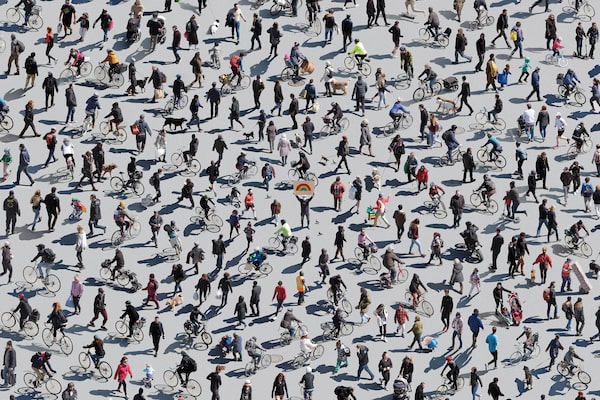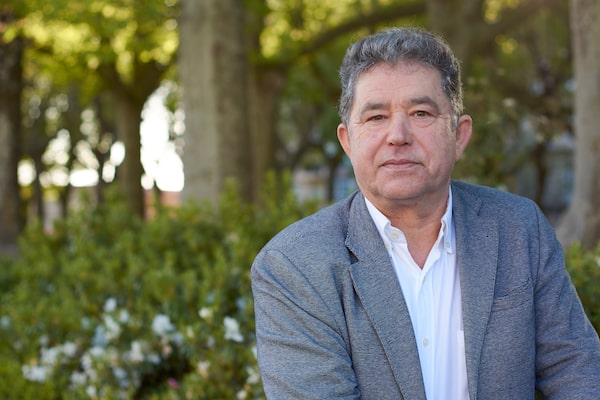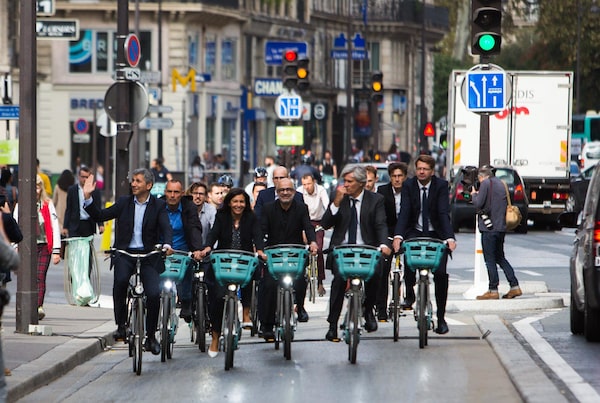
Illustration by Nik Mirus/l'Éloi
One of my heroes is a minor socialist politician you’ve never heard of – Miguel Anxo Fernández Lores.
He’s the mayor of Pontevedra, Spain, and he has a spiritual loathing for cars. He ended his city’s status as a “car warehouse” – his words – more than 20 years ago, and the results were spectacular. Pontevedra is cleaner, safer and thriving like never before.
Today, nearly a year after the start of the COVID-19 pandemic, other European cities are starting to take Mr. Fernández Lores’s lead. The pandemic is giving them a rare chance to reinvent themselves. When the deadly virus arrived, citizens suddenly didn’t want to stuff themselves into subways, buses and taxis, and the spring lockdowns convinced them that streets without cars could be rather pleasant. Gone were the diesel fumes and the noise. You could hear the birds sing, didn’t have to shout to have a conversation outdoors, or fear that your kids would get flattened if they chased a ball into the road.
Biking went mainstream virtually overnight, and cities such as Paris and Milan pushed the notion of “the 15-minute city,” where all of life’s necessities are within a 15-minute reach by foot or bike. The concept will trigger profound economic and social change if it catches on. I think it will; it’s already happening. Sixty years after she wrote The Death and Life of Great American Cities, Jane Jacobs, the late American-Canadian urbanologist who advocated mixed-use 'hoods devoid of expressways, is being vindicated.
For decades, cities everywhere have tried to reduce traffic congestion, but it never really worked because everyone owned cars, and drivers voted. So mayors mostly tinkered. Parking rates went up, and a few streets in the urban cores – very few – were narrowed or cut off from traffic. Road and highway construction continued, and ever-fatter cars and SUVs naturally filled the available space. The Urban Institute think-tank in Washington says local and state governments in 1977 spent US$93-billion on highways and roads (in 2017 inflation-adjusted dollars). In 2017, the figure had almost doubled, to US$181-billion. Cutting road and highway budgets was considered political suicide, and more than a few mayors adopted aggressive pro-car stands even as their cities filled with eye-watering smog and hideous parking lots. One of them was the late Toronto mayor Rob Ford, who merrily eliminated bike lanes.
Mr. Fernández Lores didn’t tinker. He went radical.

Pontevedra's Mayor Miguel Anxo Fernández Lores severely restricted cars and parking spaces over the past 20 years, and in the pandemic other European cities have followed his lead.Supplied
Pontevedra is a Galician city of about 83,000 on the Atlantic, just north of the Portuguese border. When Mr. Fernández Lores, now 66, was elected mayor in 1999, he inherited a pretty but ailing little metropolis. The historic centre was plugged with cars, and its narrow streets were filled with fumes and drug dealers. The street in front of his office saw 14,000 cars pass by a day. In a 2018 interview with The Guardian, he said he found the centre “dead."
Within a month, he and his team swung into action. The entire historic centre was made a car-free pedestrian area. Surface parking spots were eliminated, opening up almost 1,700 spots for public use, and underground ones were built on the periphery. In the outer zones, they replaced traffic lights with roundabouts to ease traffic flow and end the gunning of engines at green lights, and brought speed limits down to 30 kilometres an hour. Footpaths, bike lanes and green space were added.
It wasn’t supposed to work, but it did. He got some pushback from motorists, who thought they had the right to park two tonnes of metal and rubber next to medieval buildings, but only some. Years before the pandemic persuaded other mayors to follow a similar route, Pontevedra was lauded as an urban renewal model and has won several international awards, including the UN-Habitat award in 2014. “Most children now walk to school alone, and the streets have become alive and filled with people,” the UN said.
The city claims zero traffic deaths since 2008, a 70-per-cent reduction in carbon dioxide emissions, 12,000 new inhabitants (no small achievement in a country whose towns are depopulating fast), a drop in crime and a 30-per-cent increase in business revenues. Ms. Jacobs, who was instrumental in stopping the Lower Manhattan Expressway in the 1960s and Toronto’s Spadina Expressway a decade later, would have approved. She always asked: Are we building cities for cars or for people?

Transforming Rome, where I live, into an enormous Pontevedra might never happen. Romans love their cars and motorbikes, and the city has never elected a mayor with the clout and imagination to do what Mr. Fernández Lores did. Still, the city is a bit more liveable than it was before the pandemic. Mayor Virginia Raggi is having 150 kilometres of permanent and temporary bike lanes built, and the national government has subsidized the purchase of new bikes, which are in such high demand that manufacturers can’t build them fast enough. (I bought a Belgian bike in August and it has yet to arrive.) Rome’s notoriously awful traffic is a bit less awful today.
The city that does have the potential to become an enormous Pontevedra is Paris, whose Spanish-born mayor, Anne Hidalgo, was making the streets more people-friendly well before the pandemic hit. She has used the disease to accelerate that effort. “Paris is a really important model for other cities,” says Brent Toderian, who was Vancouver’s chief planner from 2006 to 2012 and now runs an urban design consultancy called Toderian UrbanWorks. “She had entirely rethought vehicle use and movement.”
Ms Hidalgo, 61, is a member of France’s Socialist Party and was first elected Paris mayor in 2014. She came in with a vision – a clever one. Instead of launching a war against cars and climate change per se, she went after air pollution, a quality-of-life issue that ensured broad buy-in. Who could be against breathable air?
By 2016, she had introduced “Paris Respire” days that eliminated cars from most areas of the centre on the first Sunday of each month and made public transportation free on those days. Later, she turned the busy highway that runs along the north side of the River Seine into a riverside park. “European cities, like Paris, were smart to focus on air pollution rather than climate change,” says Mr. Toderian. “Air pollution is real for people. You can see it, smell it. People liked what she did.”
Before the pandemic hit, Ms. Hidalgo ramped up her effort to reduce pollution, which meant getting Parisians out of cars and onto bikes and pedestrian walkways. She is creating 1,400 kilometres of bike lanes throughout Paris – almost every street will have a lane – and has removed thousands of surface parking spots. Her plan is to get rid of 60,000 of them, or about 70 per cent of the total. The major east-west artery, Rue de Rivoli, went car-free when Paris emerged from lockdown in May. From 2024, diesel cars will be banned.
The pandemic is accelerating Paris’s transformation, and there is more to come with the attempt to create a 15-minute city, an idea pioneered by Carlos Moreno, a professor of innovation at the Sorbonne University in Paris and an adviser to the mayor. The idea is to give Parisians access to all essential services – stores, public transportation, schools, banking, medical care, parks, even garden plots – in the area in which they live, removing the need for car ownership.

Paris Mayor Anne Hidalgo inaugurates a new bike path on Rue de Rivoli in 2018. Bike lanes like these have played an important part in Paris's post-pandemic transformation.Raphael Lafargue/ABACAPRESS.COM/The Canadian Press
Creating a 15-minute city will be a slow burn. It will require zoning and bylaw changes to allow mixed-use neighbourhoods, such as licensing nightclubs to operate as yoga centres during the daytime, and high schools as adult learning centres at night. Big-box retailers would have to create downsized stores that fit into normal streets (as IKEA is experimenting with). More local schools would have to be built to reduce the need for kids to travel far.
The idea of divided cities – work here, live there, shop way over there – would end. The idea is to make car journeys unnecessary, and that means electric-car journeys, too. It’s ambitious but doable. In cities, the rhythm of local life prevailed before the onslaught of the car and the arrival of the entirely car-dependent suburbs. The work-from-home phenomenon, a byproduct of the pandemic, will help cities go back to the future.
More than a few European cities are emulating, or hope to emulate, the Paris model. One is Milan, Italy’s commercial capital, which is also discouraging car use by handing over streets to cyclists and pedestrians. The Lithuanian capital, Vilnius, where a former mayor once used an armoured military vehicle to crush a car parked in a bike lane, is doing the same.
But it won’t work everywhere. Athens botched its “Great Walk” project, conceived only last year, to turn car-clogged streets in the centre into gracious, tree-lined pedestrian boulevards. The project was poorly designed, executed and marketed to the public. Edinburgh, one of northern Europe’s best-preserved old cities, is struggling to add bike lines and pedestrian-only streets.
Anthony Robson, an Edinburgh solicitor and bike-lane lobbyist, says Conservative factions and motorists are resisting the idea of adopting a strategy similar to Paris’s. “The Conservative councillors equated more cars with more shopping,” he says. “They said, ‘No cars, no commerce.' We’ve been trying to debunk this notion.”
Maybe those councillors should hop a plane to Paris or Pontevedra, two cities that, for decades, focused on making life easy for motorists. When they reversed course, the cities became more liveable, breathable, pleasant and vibrant. There’s a reason millions of tourists flock to Venice (or did before the pandemic). A city without cars is a magical experience for them.
A Parisian rides her bicycle in Rue de Rivoli on a sunny September day.Gonzalo Fuentes/Reuters/Reuters
Editor’s note: An earlier version of this article included an incorrect spelling on a photo credit for Nik Mirus.